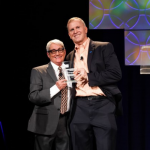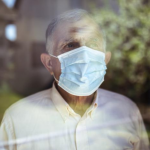LGBTQ+ NYers of Color Face Highest Hurdles; AARP NY, AARP Foundation & SAGE Urge Policy Solutions to Reduce the Inequities
NEW YORK, N.Y. — LGBTQ+ New Yorkers age 50+ face steeper barriers to healthcare, higher rates of poverty, and greater challenges to their economic security than their non-LGBTQ+ counterparts, and the COVID-19 crisis has only exacerbated these disparities, according to new groundbreaking research released today.
Disrupting Disparities: Solutions for LGBTQ+ New Yorkers Age 50+, commissioned by AARP New York and SAGE with support from the AARP Foundation, was unveiled by the leaders of the organizations, who were joined by the chairs of the State Legislature’s Aging Committees, Senator Rachel May and Assemblyman Ron Kim; Assembly Health Committee Chair Richard Gottfried; and other key state lawmakers (see quotes from legislators).
The first-of-its-kind report found:
- 23% of LGBTQ+ New Yorkers of all ages cite inadequate insurance coverage as the most significant barrier to healthcare;
- One-third of LGBTQ+ 50+ live at or below 200% of the federal poverty level, compared to a quarter of non-LGBTQ+ people;
- 21% of LGBTQ+ 50+ have provided care to friends – three and a half times the 6% of non-LGBTQ+ peers.
“This is unacceptable,” said AARP New York State Director Beth Finkel. “We are calling on state lawmakers to address this right now. It’s even worse for LGTBQ people of color and transgender older people. And the pandemic has only exacerbated these disparities.”
While nearly one-third of LGBTQ+ New Yorkers are over the age of 50, this rapidly growing elder population remains largely invisible and faces disparities rooted in years of discrimination, lack of legal and social recognition, reduced access to inclusive services, and more. After decades of admirable resilience, LGBTQ+ older people are still facing negative health, economic, and social implications that demand action.
“For decades, SAGE has seen the realities of this report first-hand. While we have certainly made progress since Stonewall, LGBTQ+ elders can’t afford to keep waiting for vital policies to protect their rights and promote their well-being,” said Michael Adams, SAGE CEO. “We’re thrilled that SAGE’s partnership with AARP New York brings the full weight of the country’s most influential advocate for older Americans to the public policy table on behalf of LGBTQ+ elders.”
“In New York, LGBTQ+ adults 50 and older, especially those of color, face unique challenges as they age, leading to widespread disparities in their health, economic security, caregiving, housing, and social connections,” said Lisa Marsh Ryerson, President of AARP Foundation. “These challenges have worsened during the COVID-19 pandemic. Though we’ve made significant progress in tackling these problems since we launched ‘Disrupt Disparities’ in 2018, we must do more to level the playing field so that all LGBTQ+ New Yorkers can live healthy, financially secure, socially connected lives and thrive as they age.”
“The COVID-19 pandemic has laid bare the unconscionable health and financial disparities that are made more difficult by the racial identity, sexual orientation, and gender identity of older New Yorkers,” said Nii-Quartelai Quartey, Ed.D., AARP Senior Advisor & National LGBTQ+ Liaison. “The action steps taken by local, state, and federal leaders from New York have the potential to offer the nation examples to narrow some of the most persistent disparities based on the lived experience of LGBTQ+ older adults on the margins in our communities.”
The unique and steadily worsening disparities among this population of LGBTQ+ New Yorkers include:
- Mental and physical health disparities due to the lack of competent, inclusive health care, and lifelong experiences of discrimination. These disparities include 41% of LGBTQ+ older people reporting having a disability compared to 35% of non-LGBTQ+ older people, poor physical and mental health, alcohol and tobacco use, HIV, and cancer, which put LGBTQ+ older people at risk of experiencing COVID-19 more acutely. One study found about 40% of LGBTQ+ older respondents in their 60s and 70s reported that their healthcare provider did not know about their sexual orientation.
- Economic insecurity since older LGBTQ+ people have fewer financial resources and are more likely to be low-income compared to non-LGBTQ+ older people. Poverty rates are even higher for LGBTQ+ older people of color, those aged 80 and older, bisexual older people, and transgender older people. And 44% of LGBTQ+ older people report being concerned about having to work well beyond retirement age – nearly double the 26% of non-LGBTQ+ people – in large part because LGBTQ+ older people whose spouse or partner died or retired before the freedom to marry may be unable to access Social Security survivor benefits or their partner’s benefits or assets. What’s more, 83% of LGBTQ+ older people report relying most on Social Security to fund their retirement years, with a majority concerned that cuts to Social Security would impact their future financial security.
- Limited housing options for LGBTQ+ older people, who are more likely to be low-income, face housing discrimination in senior living communities, and may have a history of housing insecurity or homelessness; 34% of LGBTQ+ older people and 54% of transgender and gender nonconforming older people fear having to re-closet themselves when seeking elder housing. In fact, a study of older same-sex couples applying for housing in 10 states showed that 48% experienced overt discrimination in the application process compared to different-sex couples.
- Isolation and a disconnectedness from services because they have thinner support networks. LGBTQ+ older people are far more likely to live alone and far less likely to rely on adult children or other family members for informal caregiving. Social isolation can be difficult to overcome because there are fewer opportunities to socialize in age-friendly and LGBTQ+-inclusive environments.
As with the initial launch of the Disrupt Disparities initiative in January 2018, Disrupt Disparities 2.0 in January 2020 and Disrupt Disparities 3.0 in November 2020, the latest report includes an array of policy and legislative solutions that can serve as a roadmap for elected officials and policymakers at the federal, state, and local levels of government to prioritize in the coming years.
SAGE, AARP New York and other advocates will be pushing for the following solutions outlined in the report:
- Have New York State formally designate LGBTQ+ older people and those living with HIV as groups of “greatest social need” under the federal Older Americans Act – as California, Massachusetts and Illinois have done – to drive greater aid for senior services to those populations.
- Ensure families of choice fall under the definition of family in New York State laws and policies.
- Include non-biological individuals and domestic partners under the definition of caregiver, along with spouses and biological relatives, as part of a new comprehensive caregiving state law.
- Explicitly prohibit discrimination based on gender identity or expression in the New York State Office for the Aging’s equal access guidance and provide additional guidance on the respectful treatment of transgender New Yorkers.
- Adopt an LGBTQ+ long-term care residents’ bill of rights.
- Establish an independent Long-Term Care Task Force to examine the state of long-term care and the broader long-term care system.
- Mandate a minimum level of LGBTQ+ cultural competency training for state-funded providers from organizations with expertise in LGBTQ+ aging.
- Expand LGBTQ+ programming and targeted outreach to LGBTQ+ older people to ensure that existing programming is LGBTQ+-competent.
- Establish a statewide standing Commission on LGBTQ+ Aging to identify challenges, share best practices, and develop recommendations on ways to improve quality of life.
Follow us on Twitter: @AARPNY @SAGEUSA and Facebook: AARP New York @SAGE
About AARP
AARP is the nation’s largest nonprofit, nonpartisan organization dedicated to empowering people 50 and older to choose how they live as they age. With a nationwide presence and nearly 38 million members, AARP strengthens communities and advocates for what matters most to families: health security, financial stability and personal fulfillment. AARP also produces the nation’s largest circulation publications: AARP The Magazine and AARP Bulletin. To learn more, visit www.aarp.org or follow @AARP and @AARPadvocates on social media.
About AARP Foundation
AARP Foundation works to end senior poverty by helping vulnerable older adults build economic opportunity and social connections. As AARP’s charitable affiliate, we serve AARP members and nonmembers alike. Bolstered by vigorous legal advocacy, we spark bold, innovative solutions that foster resilience, strengthen communities and restore hope. To learn more, visit www.aarpfoundation.org or follow @AARPFoundation on social media.
About SAGE
SAGE is the country’s largest and oldest organization dedicated to improving the lives of lesbian, gay, bisexual, and transgender (LGBTQ+) older people. Founded in 1978 and headquartered in New York City, SAGE is a national organization that offers supportive services and consumer resources to LGBTQ+ older people and their caregivers. SAGE also advocates for public policy changes that address the needs of LGBTQ+ elders, provides education and technical assistance for aging providers and LGBTQ+ community organizations through its National Resource Center on LGBTQ+ Aging, and cultural competency training through SAGECare. With staff located across the country, SAGE also coordinates SAGENet, a growing network of affiliates in the United States. Learn more at sageusa.org.







